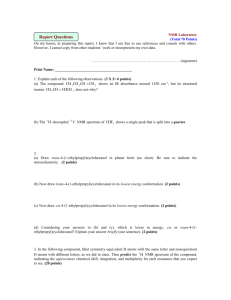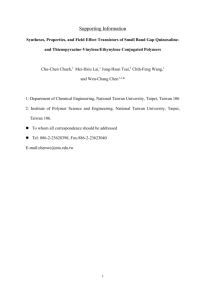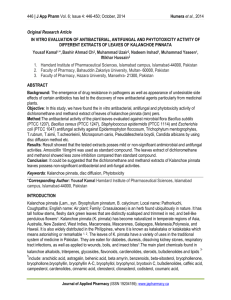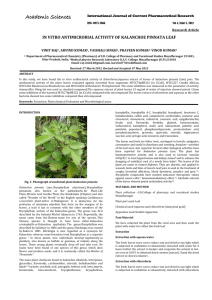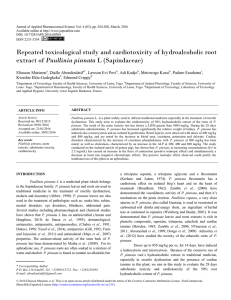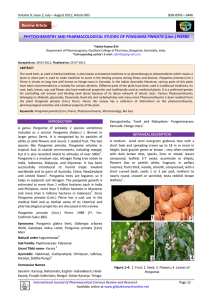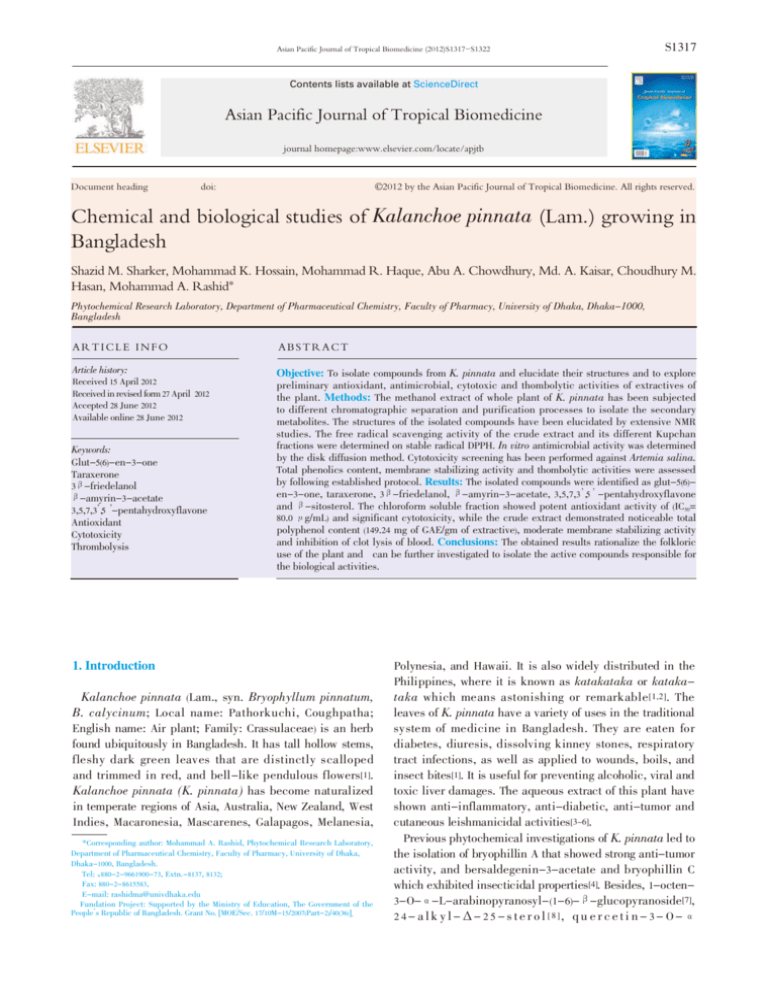
Asian Pacific Journal of Tropical Biomedicine (2012)S1317-S1322
S1317
Contents lists available at ScienceDirect
Asian Pacific Journal of Tropical Biomedicine
journal homepage:www.elsevier.com/locate/apjtb
Document heading
doi:
襃2012
by the Asian Pacific Journal of Tropical Biomedicine. All rights reserved.
Chemical and biological studies of Kalanchoe pinnata (Lam.) growing in
Bangladesh
Shazid M. Sharker, Mohammad K. Hossain, Mohammad R. Haque, Abu A. Chowdhury, Md. A. Kaisar, Choudhury M.
Hasan, Mohammad A. Rashid*
Phytochemical Research Laboratory, Department of Pharmaceutical Chemistry, Faculty of Pharmacy, University of Dhaka, Dhaka-1000,
Bangladesh
ARTICLE INFO
ABSTRACT
Article history:
Received 15 April 2012
Received in revised form 27 April
Accepted 28 June 2012
Available online 28 June 2012
Objective: To isolate compounds from K. pinnata and elucidate their structures and to explore
preliminary antioxidant, antimicrobial, cytotoxic and thombolytic activities of extractives of
the plant. Methods: The methanol extract of whole plant of K. pinnata has been subjected
to different chromatographic separation and purification processes to isolate the secondary
metabolites. The structures of the isolated compounds have been elucidated by extensive NMR
studies. The free radical scavenging activity of the crude extract and its different Kupchan
fractions were determined on stable radical DPPH. In vitro antimicrobial activity was determined
by the disk diffusion method. Cytotoxicity screening has been performed against Artemia salina.
Total phenolics content, membrane stabilizing activity and thombolytic activities were assessed
by following established protocol. Results: The isolated compounds were identified as glut-5(6)en-3-one, taraxerone, 3毬-friedelanol, 毬-amyrin-3-acetate, 3,5,7,3榮,5榮-pentahydroxyflavone
and 毬-sitosterol. The chloroform soluble fraction showed potent antioxidant activity of (IC50=
80.0 毺g/mL) and significant cytotoxicity, while the crude extract demonstrated noticeable total
polyphenol content (149.24 mg of GAE/gm of extractive), moderate membrane stabilizing activity
and inhibition of clot lysis of blood. Conclusions: The obtained results rationalize the folkloric
use of the plant and can be further investigated to isolate the active compounds responsible for
the biological activities.
Keywords:
Glut-5(6)-en-3-one
Taraxerone
2012
3毬-friedelanol
毬-amyrin-3-acetate
3,5,7,3榮,5榮
-pentahydroxyflavone
Antioxidant
Cytotoxicity
Thrombolysis
1. Introduction
Kalanchoe pinnata (Lam., syn. Bryophyllum pinnatum,
B. calycinum; L ocal name: P athorkuchi, C oughpatha;
English name: Air plant; Family: Crassulaceae) is an herb
found ubiquitously in Bangladesh. It has tall hollow stems,
fleshy dark green leaves that are distinctly scalloped
and trimmed in red, and bell-like pendulous flowers[1].
Kalanchoe pinnata (K. pinnata) has become naturalized
in temperate regions of Asia, Australia, New Zealand, West
Indies, Macaronesia, Mascarenes, Galapagos, Melanesia,
*Corresponding author: Mohammad A. Rashid, Phytochemical Research Laboratory,
Department of Pharmaceutical Chemistry, Faculty of Pharmacy, University of Dhaka,
Dhaka-1000, Bangladesh.
Tel: +880-2-9661900-73, Extn.-8137, 8132;
Fax: 880-2-8615583,
E-mail: rashidma@univdhaka.edu
Fundation Project: Supported by the Ministry of Education, The Government of the
People榮s Republic of Bangladesh. Grant No. [MOE/Sec. 17/10M-15/2007(Part-2)/40(36)].
Polynesia, and Hawaii. It is also widely distributed in the
Philippines, where it is known as katakataka or katakataka which means astonishing or remarkable [1,2]. T he
leaves of K. pinnata have a variety of uses in the traditional
system of medicine in Bangladesh. They are eaten for
diabetes, diuresis, dissolving kinney stones, respiratory
tract infections, as well as applied to wounds, boils, and
insect bites[1]. It is useful for preventing alcoholic, viral and
toxic liver damages. The aqueous extract of this plant have
shown anti-inflammatory, anti-diabetic, anti-tumor and
cutaneous leishmanicidal activities[3-6].
Previous phytochemical investigations of K. pinnata led to
the isolation of bryophillin A that showed strong anti-tumor
activity, and bersaldegenin-3-acetate and bryophillin C
which exhibited insecticidal properties[4]. Besides, 1-octen3-O-毩-L-arabinopyranosyl-(1-6)-毬-glucopyranoside[7],
2 4 - a l k y l - Δ - 2 5 - s t e r o l [8], q u e r c e t i n - 3 - O - 毩
S1318
Shazid M. Sharker et al./Asian Pacific Journal of Tropical Biomedicine (2012)S1317-S1322
-L-arabinopyranosyl-(1-2)-毩-L-rhamnopyranoside[9] have
also been reported from this plant.
As a part of our systematic studies on medicinal plants
of Bangladesh[10,11], we studied K. pinnata and we, herein,
report isolation of compounds for the first time from this
plant. The preliminary antioxidant, antimicrobial, cytotoxic
activities are also reported here.
2. Materials and methods
2.1. General experimental procedure
NMR spectra were recorded using a Bruker AMX-400 (400
13
MHz for 1H and 100 MHz for C) instrument in deuterated
chloroform and the δ values for 1H and 13C spectra were
referenced relative to the residual non-deuterated solvent
signals.
2.2. Plant material
T he whole plants of K. pinnata were collected from
N arsingdi in N ovember 2009 and was identified by the
experts of Bangladesh National Herbarium where a voucher
specimen (DACB Accession number-35468), representing
this collection has been deposited.
2.3. Chemicals
1,1-Diphenyl-2-picryl-hydrazyl (DPPH) and ascorbic acid
were purchased from Sigma Chemical Co. Ltd, (St. Louis,
MO, USA). Lyophilized streptokinase vials (1 500 000 I.U.) were
obtained from Beacon Pharmaceutical Ltd. Bangladesh. All
other chemicals and reagents were of analytical grade.
2.4. Extraction and isolation
The air dried and powdered material (450 g) was extracted
with 2 L of methanol in a large flask at room temperature
for 15 days with occasional shaking and stirring. The whole
mixture was then filtered off through a filter paper and
the filtrate thus obtained was concentrated at 40 曟 with
a rotary evaporator. A portion (5.0 g) of the concentrated
methanol extract was fractionated by the modified Kupchan
partitioning protocol[12] to afford petroleum ether (700 mg),
carbon tetrachloride ( 400 mg ) , chloroform ( 900 mg ) and
aqueous (2.8 g) soluble materials.
A portion of the crude methanolic extract (10.0 g) was
subjected to vacuum liquid chromatography (VLC) over
silica gel 60H (100-200 mesh). The column was eluted with
petroleum ether, followed by mixtures of petroleum ether
and ethyl acetate, then with ethyl acetate and finally with
ethyl acetate and methanol mixtures of increasing polarities.
D epending on the TLC behaviors, fractions 1 - 4 A and
13A-16 eluted with 3%-15% ethyl acetate in petroleum ether
and 5%-30% methanol in ethyl acetate, respectively were
selected for further investigation.
Fractions 1-4A were mixed together and further subjected
to column chromatography over silica gel (Kieselgel, mesh
70-230) using petroleum ether and ethyl acetate mixtures of
increasing polarities. A total of 50 fractions were collected.
Depending on TLC behaviors, fractions 12, 17, 18, 20, 35 were
selected for further purification. Evaporation of solvents from
each of these provided white crystalline mass. Repeated
washings with ethyl acetate allowed to remove the colored
impurities and provided Glut-5(6)-en-3-one (compound 1,
5.6 mg), Taraxerone (compound 2, 6.1 mg), 3毬-Friedelanol
(compound 3, 4.5 mg), 毬-Amyrin-3-acetate (compound 4,
6.5 mg) and 3,5,7,3榮,5榮-Pentahydroxyflavonoe (compound
5, 4.3 mg). VLC fractions 13A-16 were bulked and subjected
to gel permeation chromatography over Sephadex (LH-20)
using n-hexane-dichloromethane-methanol ( 2 : 5 : 1 ) as
the mobile phase. A total of 40 fractions were collected.
Preparative thin layer chromatography of column fraction
25, over silica gel using 10% ethyl acetate in petroleum ether
yielded 毬-Sitosterol (compound 6, 6.5 mg).
2.4.1.Glut-5(6)-en-3-one
White crystals, m.p. 208-210 曟[13-14]; 1H NMR (400 MHz,
CDCl3): δ 5.69 (1H, m, H-6), 0.82 (3H, s), 0.96 (3H, s), 1.00 (3H,
s), 1.03 (3H, s), 1.07 (3H, s), 1.17 (3H, s), 1.23 (3H, s), 1.24 (3H, s);
13C NMR (100 MHz, CDCl3): see Table 1.
Table 1.
C NMR (100 MHz) spectral data of compounds 1, 2, 4 and 6 in CDCl3.
13
Position
1
2
4
6
18.2
38.7
39.0
37.3
3
215.5
217.7
79.9
72.4
5
141.6
56.1
55.2
140.8
23.6
35.5
33.2
31.5
1
2
4
27.8
40.8
6
122.0
8
47.4
7
9
34.8
10
49.6
12
30.3
11
13
14
15
16
17
18
19
20
21
22
23
24
25
26
27
28
29
30
34.6
34.5
47.9
20.3
39.2
49.1
36.1
17.8
27.9
39.1
18.5
40.0
47.0
37.0
17.8
31.6
42.2
122.6
31.5
50.2
36.4
21.5
38.1
124.0
40.0
37.8
158.0
42.8
56.8
36.0
37.0
39.3
32.1
30.1
43.0
34.8
20.2
33.1
38.9
28.9
25.5
16.2
19.6
18.4
32.1
34.5
32.1
38.1
117.5
37.9
49.2
41.0
29.1
33.9
33.4
26.5
21.7
15.1
30.2
25.9
30.3
33.7
21.8
139.0
28.1
26.0
34.0
59.8
39.2
39.7
31.6
41.6
28.6
15.9
15.0
16.7
23.4
28.5
23.5
21.5
42.4
24.2
28.3
56.3
12.0
19.4
36.4
18.9
33.8
25.8
48.3
26.1
18.7
18.8
22.8
12.2
-
Shazid M. Sharker et al./Asian Pacific Journal of Tropical Biomedicine (2012)S1317-S1322
2.4.2. Taraxerone
White crystals; m.p. 242-245 曟[15]; 1H NMR (400 MHz,
CDCl3): δ 5.58 (1H, dd, J=8.0, 3.2 Hz, H-15), 2.57 (1H, ddd,
J=16.0, 7.6, 3.2 Hz, Ha-2), 2.33 (1H, ddd, J=16.0, 6.4, 3.6 Hz,
Hb-2), 0.83 (3H, s), 0.91(3H, s), 0.92 (3H, s), 0.96 (3H, s), 1.07
(3H, s), 1.08 (3H, s), 1.09 (3H, s), 1.14 (3H, s); 13C NMR (100
MHz, CDCl3): see Table 1.
2.4.3. 3毬-Friedelanol
White amorphous powder; m.p. 242-244 曟[16]; 1H NMR (400
MHz, CDCl3): δ 1.90 (1H, dt, J=10.4, 2.4 Hz, Ha-2), 1.74 (1H,
dt, J=12.8, 3.2 Hz, Ha-6), 3.74 (1H, m, H-3), 0.97 (s, H3-24),
0.80 (s, H3-25), 0.99 (s, H3-26), 1.01 (s, H3-27), 1.17 (s, H3-28),
0.95 (s, H3-29), 1.00 (s, H3-30).
2.4.4. 毬-Amyrin-3-acetate
White crystalline mass; m.p. 241-243 曟[17]; 1H NMR (400
MHz, CDCl3): δ 5.18 (1H, t, J=3.2, Hz, H-12), 4.50 (1H, dd,
J=8.0, 3.0 Hz, H-3), 2.04 (3H, s, CH3-COO), 0.83 (3H, s), 0.87 (2
暳CH3), 0.88 (2暳CH3), 0.96 (3H, s), 0.97 (3H, s) and 1.13 (3H, s).
13
The C NMR (100 MHz, CDCl3): see Table 1.
2.4.5. 3,5,7,3榮,5榮-Pentahydroxyflavonoe
Colorless gum; 1H NMR (400 MHz, CD3OD): δ 6.21 (1H, d,
J=2.0 Hz, H-6), 6.38 (1H, d, J=2.0 Hz, H-8), 7.34 (1H, d, J=2.4
Hz, H-2榮), 6.91(1H, d, J=8.4 Hz, H-5榮), 7.76 (1H, d, J=2.8
Hz, 6榮).
2.4.6. 毬-Sitosterol
Colorless mass; 1H NMR (400 MHz, CDCl3): d 3.52 (1H, m,
H-3), 5.35 (1H, d, J=6 Hz, H-6), 0.68 (3H, s, H3-18), 1.01 (3H,
s, H3-19), 0.93 (3H, d, J=6.4 Hz, H3-21), 0.83 (3H, d, J=7.2
Hz, H3-26), 0.82 (3H, d, J=7.2 Hz, H3-27), 0.85 (3H, t, J=8 Hz,
13
H3-29); C NMR (100 MHz, CDCl3): see Table 1.
2.5. Free radical scavenging activity
The free radical scavenging activities (antioxidant capacity)
of the plant extracts on the stable radical 1,1-diphenyl-2picrylhydrazyl (DPPH) were determined by the method of
Brand-Williams[18]. The antioxidant potential was assayed
from the bleaching of purple colored methanol solution of
DPPH radical by the plant extract as compared to that of
BHT by a UV-vis spectrophotometer at 517nm. Inhibition
free radical DPPH in percent (I%) was calculated as follows:
(I%)=(1-Asample/Ablank)暳100
where Ablank is the absorbance of the control reaction
all reagents except the test material ) and
Asample is the absorbance of the sample. Extract IC50 was
calculated from the graph plotted by inhibition percentage
against extract concentration.
( containing
2.6. Antimicrobial activity
S1319
The in vitro antimicrobial activity of the extractives was
determined by the standardized disk diffusion method, the
details of the procedure could be found elsewhere[19-20]. The
bacterial (Bacillus cereus, Bacillus megaterium, Bacillus
subtilis, Sarcina lutea, Staphylococcus aureus, Escherichia
coli, Salmonella typhi, Salmonella Paratyphi, Shigella
boydii, Shigella dysenteriae, Pseudomonas aeruginosa, Vibrio
mimicus, Vibrio parahaemolyticus) and fungal (Aspergillus
niger, Candida albicans, Sacharomyces cerevacae) strains
used in this experiment were collected as pure cultures
from the Institute of Nutrition and Food Science, University
of Dhaka. The activity of the test agent was determined by
measuring the diameter of zone of inhibition expressed in
millimeter.
2.7. Cytotoxicity screening
DMSO solutions of all the extractives were applied against
Artemia salina in a one-day in vitro assay[21,22]. For the
experiment, 4 mg of each of the Kupchan fractions was
dissolved in DMSO and solutions of 400, 200, 100, 50, 25, 12.50,
6.25, 3.13, 1.56, 0.78 毺g/mL were prepared by serial dilution.
Vincristine sulphate and DMSO were used as the positive
and negative control, respectively.
2.8. Total phenolics content (TPC)
TPC of methanolic extract of K. pinnata was determined by
employing established protocol described by Skerget et al.[23]
involving Folin-Ciocalteu reagent as oxidizing agent and
gallic acid as standard[24]. In the alkaline condition phenol
ionizes completely. When Folin-Ciocalteu reagent is used in
this ionized phenolic solution the reagent will readily oxidize
the phenols. U sual color of Folin-Ciocalteu reagent is
yellow and after the oxidation process the solution becomes
blue. The intensity of the color change is measured with
a spectrophotometer at 760 nm. The absorbance value will
reflect the total phenolic content of the compound[25]. The
TPC was expressed as mg of GAE (gallic acid equivalent)/100
g of the dried extract.
2.9. Membrane stabilizing activity
T he membrane stabilizing activity was assessed by
using hypotonic solution and heat induced hemolysis of
erythrocyte, by following established protocol[26,27].
2.10. Thrombolytic activity
The thombolytic activity of extractives was evaluated
by the method of Prasad and collaborators[28,29] by using
streptokinase as standard.
S1320
Shazid M. Sharker et al./Asian Pacific Journal of Tropical Biomedicine (2012)S1317-S1322
found to be 8.32, 6.31, 1.32, 1.26 and 1.12, respectively.
3. Results
The whole plant of K. pinnata provided a total of six
compounds ( 1 - 6 ) . T he structures of these compounds
were determined as glut- 5 ( 6 ) -en- 3 -one, taraxerone, 3
毬 -friedelanol, 毬 -amyrin- 3 -acetate, 3 , 5 , 7 , 3 榮, 5 榮
-pentahydroxyflavonoe and 毬 -sitosterol by extensive
analysis of spectral and physical data (Table 1) as well as by
comparison with those of structurally related compounds.
The methanol extract of K. pinnata and its petroleum
ether, carbon tetrachloride, chloroform and aqueous soluble
fractions showed significant antioxidant and cytotoxic
activities (Table 2), but weak inhibition of antimicrobial
growth. The crude methanolic extract of K. pinnata also
demonstrated the presence of high phenolic contents but it
showed moderate membrane stabilizing and thrombolytic
activities (Table 2). It is clearly evident that K. pinnata
exhibited some bioactivities which are in accordance with
the folk uses of the plant in various diseases.
29
27
O
3
23
1
11 13
10
5 25 7
24
26
20
19 22
17
15
30
29
27
28
HO
O
1
O
HO
O
4
7
5
OH
O
1
O
5
1
3
3
5
19
21
5
9
12
7
26
17
15
observed with exposure to different dose levels of the test
samples.
Table 2.
Free radical scanvenging, cytotoxic, thrombolytic activities and total
phenolic content of K. pinnata
Sample
BHT
VS
SK
ME
PESF
CTSF
CFSF
AQSF
IC50
(μg/mL)
24.0
130.0
350.0
180.0
80.0
170.0
Cytotoxic
activity
LC50 (μg/mL)
0.44
8.32
6.31
1.32
1.26
1.12
Total phenolic
content (g of
GAE/100 g of
dried extract)
149.24
-
% Clot
lysis
66.77±0.66
16.42±1.20
-
BHT=tert-butyl-1-hydroxytoluene; VS=Vincristine sulphate;
SK=Streptokinase; ME=Methanolic extract of K. pinnata; PESF=
Petroleum ether soluble fractions; CTSF= Carbon tetrachloride soluble
fraction; CFSF=Chloroform soluble fraction; AQSF=Aqueous soluble
fractions of crude methanolic extract.
24
3
21
OH
HO
11 13
109
5 25
23
2
OH
H3C
21
28
19 22
30
However, varying degree of lethality to Artemia salina was
18
4. Discussion
22
20
17
14
28
23
24
29
25
27
26
6
Figure 1.
T he methanolic crude extract of K. pinnata and its
Kupchen fructions were subjected to screening for free
radical scavenging (DPPH) activity using BHT as reference
standard. I n this investigation, the chloroform soluble
partitionate of K. pinnata showed the highest free radical
scavenging activity with IC50 value 80.00 毺g/mL. The crude
methanol extract of K. pinnata also revealed moderate free
radical scavenging activity (IC50=130.0 毺g/mL) (Table 2).
As a part of discovery of cardio protective drugs from
natural sources the methanolic extracts of K. pinnata was
assessed for thrombolytic activity. Addition of 100 毺L SK,
a positive control (30 000 I.U.), to the clots and subsequent
incubation for 90 minat 37 曟, showed 66.77% lysis of clot.
Here, distilled water was treated as negative control which
exhibited negligible percentages of lysis of clot (3.80%)
whereas the methanolic extract of K. pinnata demonstrated
thrombolytic activity by 16.41%. The mean difference in the
percentage of clot lysis the between positive and negative
controls was found to be statistically significant.
In the brine shrimp lethality bioassay, the LC50 values of
crude methanol extract and its petroleum ether, chloroform,
carbon tetrachloride and aqueous soluble fractions were
Compound 1 was obtained as white crystals, which melted
at 208-210 曟. This was identical to that reported for glut5(6)-en-3-one[13-14]. The 1H NMR spectrum of 1 displayed
an olefinic proton signal at δ 5.69 (1H, m) which could be
assigned to H-6 of a pentacyclic triterpenoid-type carbon
skeleton. It also showed eight three proton singlets at δ
0.82, 0.96, 1.00, 1.03, 1.07, 1.17, 1.23 and 1.24, which could be
attributed to eight methyl groups present in the molecule.
13
The C NMR spectrum of this revealed the presence of 30
carbon resonances. This further confirmed the presence
of a triterpene skeleton. The DEPT-135 experiment was
very informative, which exhibited signals for 8 methyl, 10
methylenes and 4 methine carbons. Thus, it had 8 quartnary
carbons. The 13C signal at δ 215.5 could be ascribed to the
ketonic (>C=O) functionality at C-3. On the basis of the
above spectral data, compound 1 was characterized as glut5(6)-en-3-one (1). The identity of this compound as glut5(6)-en-3-one (1) was further confirmed by comparison of its
spectral data with previously reported values[13,14] as well as
by co-TLC with authentic sample.
Compound 2 was obtained as white crystals. This melted
at 242-245 曟, which was identical to that published for
taraxerone[15]. The 1H NMR spectrum of 2 showed a typical
signal of one proton intensity at δ 5.61 (dd, J=8.0, 3.2 Hz),
the chemical shift and splitting pattern of which was
characteristic for an olefinic proton in a taraxerol-type
triterpenoid carbon skeleton. The pair of double doublets
centered at δ 2.57 (1H, ddd, J=16.0, 7.6, 3.2 Hz) and 2.33 (1H,
Shazid M. Sharker et al./Asian Pacific Journal of Tropical Biomedicine (2012)S1317-S1322
ddd, J=16.0, 6.4, 3.6 Hz) could be attributed to Ha-2 and
Hb-2, respectively. The 1H NMR spectrum also showed
eight methyl singlets at δ 0.83, 0.91, 0.92, 0.96, 1.07, 1.08, 1.09
and 1.14. The absence of an oxymethine proton in the 1H
NMR spectrum and the presence of a carbon signal at 217.6
ppm in the 13C NMR spectrum confirmed the presence of
a ketonic group in this molecule. The 13C NMR spectrum of
compound 2 displayed the presence of 30 carbon resonances.
This furthers substantiated the presence of a triterpene
skeleton. The DEPT-135 experiment differentiated these
carbon signals into 8 methyl, 10 methylenes, 4 methine
carbons. T hus, compound 2 had 8 quartnary carbons.
13
Careful interpretation of the 1H and C NMR data allowed
to characterize compound 2 as taraxerone (taraxa-14-en3-one), the identity of which was further substantiated by
comparison with published values[15].
Compound 3 was obtained as white amorphous powder.
T his powder decomposed at 242 - 244 曟 , which was in
close agreement to that of 3毬-friedelanol[16]. The 1H NMR
spectrum of 3 appeared a pair of doublet of triplets centered
at δ 1.90 (1H, dt, J=10.4, 2.4 Hz) and 1.74 (1H, dt, J=12.8, 3.2
Hz) which could be assigned to Ha-2 and Ha-6, respectively.
The presence of a multiplet δ 3.74 indicated an oxymethine
proton at H-3 position. The chemical shift and splitting
of this proton signal was typical for 3毬-friedelanol type
triterpenoid skeleton. The 1H NMR spectrum also showed
one three proton doublets at δ 0.95 (H3-23) and seven three
proton singlets at δ 0.97 (H3-24), 0.80 (H3-25), 0.99 (H3-26),
1.01 (H3-27), 1.17 (H3-28), 0.95 (H3-29) and 1.00 (H3-30). On this
basis, compound 3 was characterized as 3毬-friedelanol (3).
The identity of 3 as 3毬-friedelanol was further confirmed by
comparison of its spectral data with literature values[16].
Compound 4 was obtained as white crystalline mass, with
m.p. of 241-243 曟. This was identical to that published
for 毬-amyrine-3-acetate[17]. The 1H NMR spectrum of 4
reveled a triplet (J=3.2 Hz) of one proton intensity at δ 5.18
characteristic for H-12 and a downfield oxymethine proton
at δ 4.50 (1H, dd, J=8.0, 3.0 Hz). The downfield resonance of
this signal demonstrated that C-3 was esterified. This was
supported by a methyl group singlet at δ 2.04 (CH3CO). The
1H NMR spectrum also showed eight methyl signals at δ
0.83 (3H, 1暳CH3), 0.87 (6H, 2暳CH3), 0.88 (6H, 2暳CH3), 0.96
13
(3H, s), 0.97 (3H, s) and 1.13 (3H, s). The C NMR spectrum
of compound 4 was very informative, which revealed
the presence of 32 carbon atoms including signals for a
carbonyl and acetyl methyl group. Thus, compound 4 was
characterized as 毬-amyrin-3-acetate. Its identity was
confirmed by comparison of its spectral data with reported
values[17], as well as co-TLC with authentic sample.
The 1H NMR spectrum of compound 5 exhibited a pair of
doublets (J=2.0 Hz) at δ 6.38 (1H) and 6.21 (1H) characteristic
for H-8 and H-6, respectively, in a flavonoid type compound.
The spectrum also demonstrated two doublets centered
at δ 6.91 (1H, J=8.4 Hz), and δ 7.34 (1H, J=2.4 Hz) and a
double doublet (J= 8.4, 2.4 Hz) at δ 7.76. These resonances
S1321
suggested the presence of a 1,3,5-trisubstituted aromatic
ring. On the basis of the above spectral data, compound 5
was characterized as 3,5,7,3榮,5榮-pentahydroxyflavone, the
identity of which was further supported by comparison of its
spectral data with reported values[30].
Compound 6 was obtained as colorless gum. The 1H NMR
spectrum of 6 allowed a one proton multiplet at d 3.52, the
position and multiplicity of which was indicative of H-3
of the steroid nucleus. The typical H-6 of the steroidal
skeleton was evident as a doublet (J=6.0 Hz) at d 5.35 that
integrated for one proton. The spectrum further revealed two
singlets at d 0.68 and 1.01 (3H each) assignable to two tertiary
methyl groups at C-13 and C-10, respectively. Two doublets
centered at d 0.82 (J=7.2 Hz) and 0.83 (J=7.2 Hz) could be
attributed to two methyl groups at C-25. The doublet at d
0.93 (J=6.4 Hz) was demonstrative of a methyl group at C-20.
On the other hand, the triplets (J=8 Hz) of three-proton
intensity at d 0.85 could be assigned to the primary methyl
group attached to C-28. The 13C NMR spectrum of compound
6 was very informative, which revealed the presence of 29
carbon atoms. The DEPT-135 experiment showed signals
for 6 methyl, 11 methylenes and 9 methine carbons. Thus, it
had 3 quaternary carbons. The above spectral features are in
close agreement to those observed for 毬-sitosterol[31]. CoTLC with an authentic sample further confirmed its identity
as 毬-sitosterol.
The antimicrobial activity of extracts from K. pinnata
was examined in the present study. The zone of inhibition
produced by the crude methanol extract and its petroleum
ether, carbon tetrachloride, chloroform, and aqueous soluble
partitionates was determined at a concentration of 400 毺g/
disc. The chloroform soluble partitionate only showed very
weak activity against the test organisms having the zone of
inhibition of 7 mm (data not shown).
The methanol extract of K. pinnata was tested for total
phenolic content by using Folin-Ciocalteu reagent. Based
on the absorbance values of the various extract solutions by
colorimetric analysis, the total phenolics of different extracts
were determined and compared with the standard solutions
of gallic acid.
The extractives of K. pinnata, at concentration 1.0 mg/
mL, significantly protected the lysis of human erythrocyte
membrane induced by hypotonic solution and heat, as
compared to the standard acetyl salicylic acid (0.10 mg/
mL). In hypotonic solution-induced haemolysis, the crude
methanolic extract inhibited 68.34% haemolysis of RBCs as
compared to 71.9% produced by acetyl salicylic acid. On
the other hand, in heat induced haemolysis, this extract
inhibited 52% haemolysis of RBCs as compared to 42.20%
demonstrated by acetyl salicylic acid (at 0.10 mg/mL).
Acknowledgements
The authors wish to thank Biomedical Research Centre,
S1322
Shazid M. Sharker et al./Asian Pacific Journal of Tropical Biomedicine (2012)S1317-S1322
University of Dhaka for laboratory facilities and The School
of Pharmacy, University of London, UK for assisting with
the NMR studies. MAR thanks to the Ministry of Education,
The Government of the People榮s Republic of Bangladesh for
financial support to him to carry out this research project.
References
[1] Ghani A. Monographs of the recorded medicinal plants. Medicinal
Plants of Bangladesh. 2nd ed. Asiatic Society of Bangladesh 2003,
p. 271-272.
[2] D escoings B . Illustrated handbook of succulent plants:
Crassulaceae. 1 st ed. N ew Y ork: S pringer- V erlag B erlin
Heidelberg; 2003, p. 169.
[3] S idhartha PA , C handhuri KW . A nti-inflammatory action of
Bryophyllum pinnatum leaf extract. Fitoterapia 1990; 41: 527-533.
[4] Supratman UT, Fujita K, Akiyama H, Hayashi A, Murakami H,
Sakai K, et al. Anti-tumor Promoting Activity of Bufadienolides
from Kalanchoe pinnata and K. daigremontiana butiflora. Biosci
Biotechnol Biochem 2000; 165: 947-949.
[5] Torres-Santos ECS, Da Silva AG, Costa APP, Santos APA, RossiBergmann B. Toxicological analysis and effectiveness of oral
Kalanchoe pinnata on a human case of cutaneous leishmaniasis.
Phytother Res 2003; 17: 801-803.
[6] Muzitano MF, Falcão CAB, Cruz EA, Bergonzi MC, Bilia AR,
Vincieri FF, et al. Oral metabolism and efficacy of Kalanchoe
pinnata flavonoids in a murine model of cutaneous leishmaniasis.
Planta Med 2009; 75: 307-11.
[7] Almeida AP, Muzitano MF, Costa SS. 3-O-a-L-arabinopyranosyl( 16 ) -b-glucopyranoside, a minor substance from the leaves
of Kalanchoe pinnata ( C rassulaceae ) . Revista Brasileira de
Farmacognos 2006; 16: 485-489.
[8] Akihisa T, Kokke WC, Tamura MC, Toshitake MT. Sterols of
Kalanchoe pinnata: First report of the isolation of both C-24
epimers of 24-alkyl-Δ25-sterols from a higher plant. Lipids
1991;26: 660-665.
[9] Muzitano MF, Tinoco LW, Carlos CG, Kaiser R, Rossi-Bergmann
B, Sonia SC. The antileishmanial activity assessment of unusual
flavonoids from Kalanchoe pinnata. Phytochem 2006 ; 67 :
2071-2077.
[10] Kaisar MA, Rahman MS, Rahman MZ, Hasan CM, Rashid MA.
A review on phytochemicals from some medicinal plants of
Bangladesh. J Pharm Nutri Sci 2011; 1: 87-95.
[11] Kabir S, Rahman MS, Chowdhury AM, Hasan CM, Rashid MA. An
unusal bisnor-clerodane diterpenoid from Polygonum simiarum.
Nat Prod Commun 2010; 5: 1543-1546.
[12] Vanwagenen BC, Larsen R, Cardellina JHII, Randazzo D, Lidert
ZC, Swithenbank C. Ulosantoin, a potent insecticide from the
sponge Ulosareutzleri. J Org Chem 1993, 58: 335-337.
[13] Ferous AJ, Mamun MA, Hasan CM. Glut-5(6)en-3-毬-ol from the
aerial parts of Scoparia dulcis. Glut-5(6)-en-3-b-ol from the
aerial parts of Scoparia dulcis. Fitoterapia 1993; 65: 469-471.
[14] Yadava RN, Chakravarti N. New antifungal triterpenoid saponin
from Launaea pinnatifida Cass. Indian J Chem 2009; 48: 83-87.
[15] Kiem PV, Minh CV, Huong HT, Nam NH, Lee JJ. Pentacyclic
triterpenoids from Mallotus apelta. Arch Pharm Res 2004; 27:
1109-1113.
[16] M aria FD , O liveira A , A na C , D e R odrigues M , M aria LBP ,
D e J efferson R , et al. D uarte C hemical constituents and
Leishmanicidal activity of Gustavia elliptica (Lecythidaceae).
Quim Nova 2011; 34: 1182-87.
[17] Ejaz A, Ahsan S, Sabbir H, Abdul M, Mukhtar UH, Munawar AM,
et al. Phytochemical and antimicrobial studies of Grewia tenax. J
Chem Soc Pak 2011, 33: 676-681.
[18] Brand-Williams W, Cuvelier ME, Berset C. Use of a free radical
method to evaluate antioxidant activity. Food Sci Tech Lebensm
Wiss Technol 1995, 28: 25-30.
[19] B arry AL . Principle and practice of microbiology. 3 rd ed.
Philadelphia: Lea& Fabager; 1976.
[20] Kamrun N, Mohammad GUK, Rahman MS, Hasan CM, Rashid
MA . A ntimicrobial and cytotoxic activities of Bryophyllum
daigremontianum. Dhaka Univ J Pharm Sci 2008; 7: 99-101.
[21] B auer AW , K irby WMM , S herris JC , T urck M . A ntibiotic
susceptibility testing by a standardized single disc method. Am J
Clin Pathol 1966; 45: 493-496.
[22] M ayorga P , P érez KR , C ruz SM , C áceres A . C omparison of
bioassays using the anostracan crustaceans Artemia salina and
Thamnocephalus platyurus for plant extract toxicity screening.
Braz J Pharmacogn 2010; 20(6): 897-903.
[23] Skerget M, Kotnik P, Hadolin M, Hras AR, Simoni M, Knez J.
Phenols, proanthocyanidins, flavones and flavonols in some plant
materials and their antioxidant activities. Food Chem 2005; 89:
191-198.
[24] Almey AAA, Khan CAJ, Zahir IS, Suleiman KM, Aisyah MR, Rahim
KK. Total phenolic content and primary antioxidant activity of
methanolic and ethanolic extracts of aromatic plants’ leaves. Int
Food Res J 2010; 17: 1077-1084.
[25] H odzic Z , P asalic H , M emisevic A , S rabovic M , S aletovic
M , P oljakovic M . T he influence of total phenols content on
antioxidant capacity in the whole grain extracts. Eur J Sci Res
2009; 28(3): 471-477.
[26] Shinde UA, Phadke AS, Nair AM, Mungantiwar AA, Dikshit VJ,
Saraf MN. Membrane stabilizing activity-a possible mechanism of
action for the anti-inflammatory activity of Cedrus deodara wood
oil. Fitoterapia 1999; 70: 251-257.
[27] Sikder MA, Kuddus MR, Kaisar MA, Karna S, Rashid MA. In vitro
membrane stabilizing activity, total phenolic content, free radical
scavenging and cytotoxic properties of Aphanamixis polystachya
(Wall.). Bangladesh Pharm J 2010; 13: 55-59.
[28] Prasad S, Kashyap RS, Deopujari JY, Purohit HJ, Taori GM,
Daginawala HF. Development of an in vitro model to study clot
lysis activity of thrombolytic drugs. Thrombosis J 2006; 4: 14.
[29] S ikder MA , S iddique AB , H ossian AKMN , M iah MK , K aisar
MA , R ashid MA . E valuation of thrombolytic activity of four
Bangladeshi medicinal plants, as a possible renewable source for
thrombolytic compounds. J Pharm Nutri Sci 2011; 1: 4-8.
[30] A lmahyl HA , R abmanj M , S ukari MA , A li BAM . S ysnthesis
and formatuion of T11223 and T1223 high-Tc superconductors.
Pertanika J Sci Tech 2003; 11: 73-81.
[31] Pateh UU, Haruna AK, Garba M, Iliya I, Sule IM, Abubakar MS, et
al. Phytochemical screening and histopathological studies on the
seeds of Colocynthis Citrullus in albino rats. Nig Journ Pharm Sci
2008; 7: 19-25.




